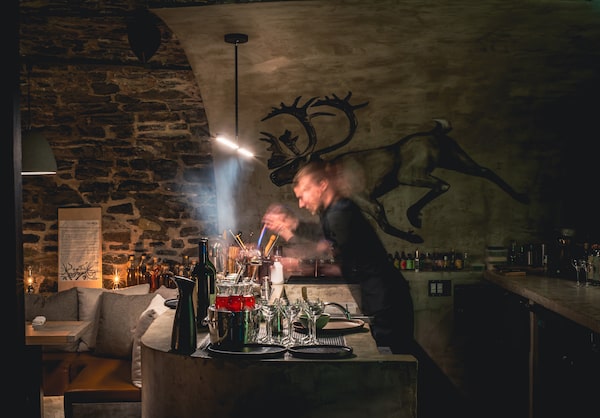
La Tanière restaurant in Quebec CitySimon Ferland/Destination Québec cité
It was probably somewhere between the second and third sips of my “welcome cocktail” – a heady mix of gin, apple vermouth, verjuice (had to look it up), smoked homemade bitters and fake sand (can’t make it up) – that a thought occurred to me: Is this all a bit much?
My wife and I were having dinner at Tanière, probably the best restaurant in Quebec City. The night before, we had had dinner at Laurie Raphaël, the other best restaurant in Quebec City. And, for my sins, I had been served lunch at Le Clan, which it turns out is also the best restaurant in Quebec City.

Offerings from La Tanière, in Quebec City.Simon Ferland/Groupe La Tanière
My mission, if I chose to accept it, was to write about a group of local chefs trying to lure the Michelin Guide to their little slice of la Nouvelle-France.
By my second day in town, I had an image of myself as one of those ducks they force-feed to make foie gras. Free pastries were literally spilling out of my coat pockets. I was hungover. (I didn’t know what seven three-ounce glasses of wine would do to me. Now I do.)
I like to eat out, sometimes even at nice places. But these were the kind of places where the plates are black, the food is sometimes foam and there are 14 courses. The kind of places that scream Michelin.
It is easy to scorn these restaurants, even easier to mock them. Look at the success of The Menu, a film that turns on skewering high-foodie pretension, and the recent journalistic takedowns of toxic work environments at critical-darling restaurants such as Copenhagen’s Noma.
The Michelin Guide is now often seen as the toxic tip of the pretentious spear – eurocentric, corrupt and a disaster for the mental and physical health of everyone involved. In other words: all a bit much.

Chef Stéphane Modat and Mr. Yanick Parent, businessman and associate, are pictured at Le Clan.Frédéric Laroche/Handout
Then again, if Quebec City wanted to vie for this dubious honour, I was going to give it a hearing.
I adore the place. Not only the enchantment of Vieux-Québec – a 17th-century European town transposed to North America and frozen in time by several weird turns of history’s wand – but the coffee shops and ramen spots of more bohemian neighbourhoods such as Saint-Roch and Limoilou, the majesty of the St. Lawrence, the grandeur of the National Assembly.
If Toronto and Vancouver deserve Michelin’s attention, I figured so might Canada’s most charming city. Over 48 absurdly decadent hours, it made an interesting case.
Quebec City has everything you could want in a centre of fine dining. Start with terroir. The provincial capital is close to the bounty of Quebec’s regions, which folks here take seriously. Alex Bouchard, co-chef at Chez Muffy – the restaurant of the Auberge Saint-Antoine, where we stayed – runs through the delicacies within three hours of his kitchen.
From the Gaspé – “our front door” – you can snatch snow crabs, lobster, halibut and cod. Oysters from the Îles-de-la-Madeleine. Whelks from Rimouski, where the little sea snails are sold in dépanneurs, next to the cheese curds and chips. Shrimp from Matane. The famously juicy blueberries of Lac-Saint-Jean, about which it’s said: “It only takes three to make a pie.” He gets his apples and strawberries from the Île d’Orléans, halfway across the river; his pork from the Beauce to the south; lamb from Kamouraska or Charlevoix; and maple syrup from the Townships. The fromageries are everywhere now, sprouting like mushrooms. The mushrooms themselves come from secret locations closely guarded by foragers.
All the restaurants vying for Michelin’s attention are locavore to different degrees, some more purist than others. (“We’re not going to deny our clients truffles from Périgord,” said Bouchard. “That would be nonsense.”) The philosophy is harder to maintain in winter when it’s a struggle to avoid serving 14 variations on rutabaga. But it turns out that these chefs enjoy the challenge, using the bare larder as a spur to creativity. My notes about one appetizer at Tanière read: “Herring bone and cow parsnip: Who knew??”
Dessert at La Tanière.Simon Ferland/Groupe La Tanière
Another homegrown resource that has only recently started sprouting: money. Quietly, Quebec City has grown rich, with higher economic growth from 2001 to 2018 than any other big Canadian city. Its unemployment rate hovers around 2 per cent, also the best in Canada. Tech and insurance have driven the boom, says the former mayor and gastronome Régis Labeaume. It’s not a sleepy government town any more, and that’s good news for restaurateurs.
“Quebec City used to be poor: It was a city of blue-collar workers and bureaucrats, and there weren’t that many bureaucrats,” said Labeaume. Now “young people have money in their pockets and they participate.”
A colourful long-time booster of the capital, he thinks his city’s dining scene can compare with anyone’s. When he brought Alain Juppé to Le Clan, the former French prime minister “adored” it, Labeaume said. (In fact, the hare meatballs served by chef Stéphane Modat at Le Clan were my single favourite dish from the trip.)

Le Clan restaurant in Quebec City.Frédéric Laroche/Destination Québec cité
A scene is built on creators but also consumers and local foodies have gotten noticeably more sophisticated over the dozen years that Raphaël Vézina has worked at Laurie Raphaël, the restaurant his parents founded three decades ago (and named after him and his sister). It was a pioneer of the movement toward local ingredients in Quebec City cuisine, but as recently as a decade ago, said Vézina, “Every other diner would ask why there isn’t steak on the menu?”
There was nothing resembling steak on the night we ate there. Because we were in the dregs of March, there were a lot of root vegetables, foraged ingredients and preserves, only prepared and presented in brilliantly inventive ways. The sweetbread-stuffed duck with beets, black walnuts and jus, along with the sweetgrass and birch syrup soufflé with parsnip jam, made me exclaim loudly. The egg and leek dish, where the leeks were seared and vinegary, and the eggs were divided into elegant strips of white and yolk next to a cloud of hollandaise, looked like a Minimalist painting but gave a big blast of hearty, tangy flavour.

Laurie Raphaël in Quebec City.Laurie Raphaël/Destination Québec cité
Deeper in the old city, in a vaulted 17th-century merchandise warehouse, Tanière makes Laurie Raphaël’s approach to haute cuisine look downright low-key. This is the place that local food writer Allison Van Rassel thinks could make the biggest splash in the Michelin Guide. She compared it to René Redzepi’s three-star temple of gastronomic foraging in Copenhagen, which has recently come under scrutiny for exploitative labour practices.
“Tanière does what Noma does, as well, without treating its employees like manure,” she said, using stronger language.

A dish from Laurie RaphaëlFrancis Fontaine/Destination Québec cité
It is hard to imagine François-Emmanuel Nicol screaming and throwing dishes, although the unassuming chef has at least enough nerve to lead the Michelin courtship. His restaurant is the most ambitious and hardcore about local ingredients, too. He estimates that 95 per cent of what is served in Tanière comes from Quebec. He serves no truffles, for example, but the “Canadian truffle” he concocted from Jerusalem artichoke, caramel and malted barley. It is one of the most surprising and delightful things on the 14-course tasting menu.
His cooking seems to come most alive with seafood – an exquisite piece of black cod, a rare cheat from B.C.; the salmon gravlax with wild strawberries and elderflower; the stunningly rich caviar, scallop and potatoes – perhaps no surprise given that his parents moved to Quebec from France to work in the shrimp fishing industry.
He knows this kind of food is elitist but manages to be thoughtful about how it might transcend that dead end. One of his cooks could open a pizzeria and sell wild rose lemonade, inspired by her use of the plant in a more rarefied setting, he suggested. Or imagine the prickly-ash pepper he likes to use in his kitchen, with its notes of Sichuan peppercorn and vanilla, in a humble fried-chicken brine.
If Nicol and his comrades succeed in popularizing their appreciation for the culinary wonders of Quebec’s farms, waters and forests – and they still have a long way to go, but everyone’s got to start somewhere – it would surely be worth more than any Michelin star.
If you go
La Tanière, 36½, rue Saint-Pierre, taniere3.com
Laurie Raphaël, 117, rue Dalhousie, laurieraphael.com
Le Clan, 44, rue des Jardins, restaurantleclan.com
The writer was a guest of Destination Québec cité. It did not review or approve the story before publication.
 Eric Andrew-Gee
Eric Andrew-Gee